
The Karl G. Jansky Very Large Array (VLA) is a centimeter-wavelength radio astronomy observatory located in central New Mexico on the Plains of San Agustin, between the towns of Magdalena and Datil, ~50 miles (80 km) west of Socorro. The VLA comprises twenty-eight 25-meter radio telescopes deployed in a Y-shaped array and all the equipment, instrumentation, and computing power to function as an interferometer. Each of the massive telescopes is mounted on double parallel railroad tracks, so the radius and density of the array can be transformed to adjust the balance between its angular resolution and its surface brightness sensitivity. Astronomers using the VLA have made key observations of black holes and protoplanetary disks around young stars, discovered magnetic filaments and traced complex gas motions at the Milky Way's center, probed the Universe's cosmological parameters, and provided new knowledge about the physical mechanisms that produce radio emission.

The Mauna Kea Observatories (MKO) are a number of independent astronomical research facilities and large telescope observatories that are located at the summit of Mauna Kea on the Big Island of Hawaiʻi, United States. The facilities are located in a 525-acre (212 ha) special land use zone known as the "Astronomy Precinct", which is located within the 11,228-acre (4,544 ha) Mauna Kea Science Reserve. The Astronomy Precinct was established in 1967 and is located on land protected by the Historical Preservation Act for its significance to Hawaiian culture. The presence and continued construction of telescopes is highly controversial due to Mauna Kea's centrality in native Hawaiian religion and culture, as well as for a variety of environmental reasons.
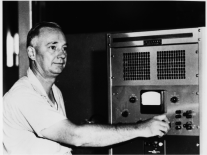
Grote Reber was an American pioneer of radio astronomy, which combined his interests in amateur radio and amateur astronomy. He was instrumental in investigating and extending Karl Jansky's pioneering work, and conducted the first sky survey in the radio frequencies.
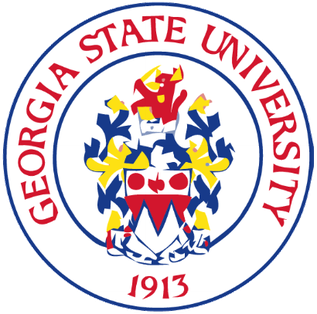
Georgia State University is a public research university in Atlanta, Georgia. Founded in 1913, it is one of the University System of Georgia's four research universities. It is also the largest institution of higher education by enrollment based in Georgia and is in the top 10 in the nation in number of students with a diverse majority-minority student population of around 54,000 students, including approximately 33,000 undergraduate and graduate students at the main campus downtown.

The Apache Point Observatory is an astronomical observatory located in the Sacramento Mountains in Sunspot, New Mexico, United States, approximately 18 miles (29 km) south of Cloudcroft. The observatory is operated by New Mexico State University (NMSU) and owned by the Astrophysical Research Consortium (ARC). Access to the telescopes and buildings is private and restricted.

The Kopernik Observatory & Science Center (KOSC), is a public observatory in Vestal, New York opened to the public on 16 June 1974 by the Kopernik Society of Broome County to commemorate the 500th anniversary of the birth of the astronomer Nicolaus Copernicus in 1973. Its mission is to offer hands-on investigations and outreach programs for educating all ages about astronomy and science using advanced optical telescopes, computers and other tools. It is the first science laboratory facility in New York State designed for K-12 teachers, students and their families, and has been one of the best-sited and best equipped public observatories in the Northeast United States for nearly the last 40 years.
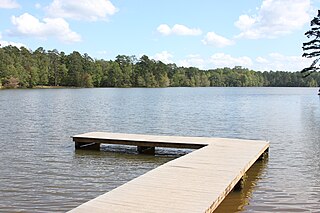
Hard Labor Creek State Park is a 5,804 acre (23.49 km²) Georgia state park located between Bostwick and Rutledge. The park is named after Hard Labor Creek, a small stream that cuts through the park. The creek's name comes either from enslaved people who once tilled the summer fields, or from Native Americans who found the area around the stream difficult to ford. The park plays host to an 18-hole public golf course, which offers a pro shop, driving range, rental cars, and senior citizen discounts. Rocky Creek provides many of the water hazards on the course including the 14th hole with its signature water wheel.
Goldendale Observatory State Park is an educational facility on the northern side of Goldendale, Washington, notable for its unusually large public telescope. The state park occupies five acres (2.0 ha) atop a 2,100-foot (640 m) hill.
The Amateur Astronomers Association of Pittsburgh (AAAP) was founded on June 9, 1929, by Chester B. Roe and Leo J. Scanlon. Since then, it has grown to over 500 members and operates two observatories in the Pittsburgh region: the Nicholas E. Wagman Observatory and the Mingo Creek Park Observatory. The club also sponsors many star parties that are open to members of the public throughout the year.
Otter Creek Observatory is an astronomical observatory, one of two units of the Otter Creek–South Harrison Observatories operated by Jefferson Community and Technical College. It is located at the Otter Creek Outdoor Recreation Area in Meade County, Kentucky, about 25 miles (40 km) southwest of downtown Louisville along the Ohio River.
University of Maryland Observatory is an astronomical observatory owned and operated by the University of Maryland, College Park. It is located in College Park, Maryland, USA. The Observatory hosts free open houses for the public twice a month, where visitors receive a lecture and access to three of the Observatory's telescopes. The open houses begin at 9 PM from May to October, and at 8 PM from November to April. The Washington Post named the Observatory open houses one of its seven favorite weekend excursions to do in the Washington metropolitan area in 2009.
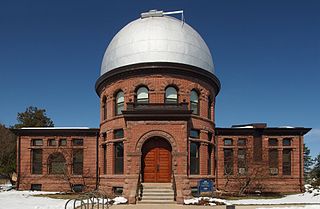
Goodsell Observatory is an observatory at Carleton College in Northfield, Minnesota, United States. It was constructed in 1887 and was, at the time, the largest observatory in the state of Minnesota. The Goodsell Observatory and its predecessor, a smaller observatory that opened in 1878, served as a widely consulted timekeeping station, bringing national prominence to Carleton College in the late 19th and early 20th centuries.

Michigan State University Observatory is an astronomical observatory owned and operated by Michigan State University. It is located south of the Michigan State University campus in East Lansing, Michigan (USA), near the corner of Forest Rd and College Rd. It has a Cassegrain telescope in its single dome. Built by Boller and Chivens, the Michigan State University telescope was commissioned in 1969 and entered regular operation in 1970. In 1974, what was at the time a state-of-the-art Raytheon Microcomputer was installed to function as a data gathering and control system. Originally, single channel photoelectric photometry and photography using plates or film were the means of acquiring data. The observatory was closed from 1981 until 1986, at a time when the university was having financial difficulties. It was reopened in the spring of 1986 on the occasion of the return of Comet Halley and has been in regular operation ever since. Since the 1980s, a CCD camera has been employed as the main instrument and the Raytheon computer has been retired. The International Astronomical Union has assigned the MSU Observatory identification code 766.

The University of Illinois Astronomical Observatory, located at 901 S. Mathews Avenue in Urbana, Illinois, on the campus of the University of Illinois Urbana-Champaign, was built in 1896, and was designed by Charles A. Gunn. It has been listed on the National Register of Historic Places since November 6, 1986, and on December 20, 1989, was designated a National Historic Landmark.

Coats Observatory is Scotland's oldest public observatory. It is currently closed for refurbishment as part of a 4-year long £42m transformation of the observatory and museum buildings. Located in Oakshaw Street West, Paisley, Renfrewshire, the observatory has been operational since 1 October 1883 and continues to function to this day, offering visitors the opportunity to view the night sky through the powerful telescopes housed within the building. The observatory is currently closed for redevelopment and is due to reopen in 2023.

Fuertes Observatory is an astronomical observatory located on the North Campus of Cornell University in Ithaca, New York. The observatory was designed by L.P. Burnham, Cornell Professor of Architecture and completed in fall of 1917. It was originally used by the Civil Engineering Department as an instructional field office for navigation and surveying. Today, the observatory is primarily used for public outreach, welcoming over two thousand visitors per year with open houses on clear Friday nights.
The Mount Stony Brook Observatory is an astronomical observatory operated by Stony Brook University in Stony Brook, New York. It is located on the roof of the Earth and Space Sciences Building. The dome contains a Meade 14" Maksutov–Cassegrain telescope and SBIG (SBIG-STL1001e) imaging equipment. The telescope is used for teaching undergraduate and graduate astronomy labs by the department, as well as by the Astronomy club. The observatory's imaging capabilities have been used to monitor variable stars. On the first Friday of every month during the school year the department hosts "Astronomy Open Nights" during which a lecture is given, followed by observing if the weather permits. The observatory was built in 1968 and Astronomy Open Nights have been held there since 1976. The current telescope was installed in 1981.

Eastern Michigan University Historic District is a historic district on the very south end of the Eastern Michigan University campus. Eastern Michigan University is a comprehensive, co-educational public university located in Ypsilanti, Michigan in Washtenaw County. The university was founded in 1849 as Michigan State Normal School. Several buildings since its founding have achieved historical significance and eventually establishing it on the National Register of Historic Places in 1984. The district was established in 1984.
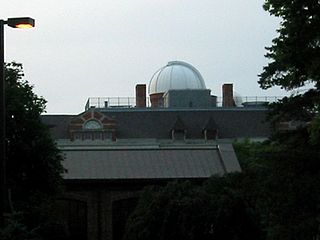
Sherzer Observatory is an astronomical observatory located on the campus of Eastern Michigan University. The observatory was established in 1903 with the construction of the new Natural Science Building, in Ypsilanti, Michigan. Following a devastating fire in 1989 a new observatory opened in September 1991 with a 10-inch (250 mm) apochromatic refractor telescope and German equatorial mount centered under a 6-meter dome.
Hard Labor Creek may refer to:














